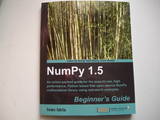6 Great Software Development Books I Own
Last week I showed you a stack of books.
They are all great books that roughly fall in the software development category. I would like to tell you something about them. Some of them I have read many times cover to cover. One of them I actually wrote myself.
1. Introduction to Algorithms
This book is like an encyclopedia of algorithms. The algorithms are presented with pseudo code so it doesn't matter what your favorite programming language is. A very rigorous mathematical approach is used for the analysis of for instance performance.
2. Groovy in Action
Groovy is a new programming language, that is based on Java, but has optional dynamic typing. Groovy also borrows features from Python and Ruby. The examples in this book appealed most to me. Even if, after reading this book as a Java developer, you still want to stick with Java, you would have learned just as much about Java as from any Java book. Groovy is after all very similar to Java.
3. Vi Improved
If you have read my blogs from the vey beginning you would know that I am a Vim fan. Even when I write code in Eclipse I try to do it the vi(m) way as much as possible. I don't recommend reading this book in one go. Rather I suggest reading a bit and then trying out what you read.
4. JUnit Recipes
JUnit is the most popular unit testing framework for Java. JUnit gives you tons of useful unit testing tips. This book is now outdated, since it covers an older version of JUnit – the one without annotations. Still I learned a lot of basic principles from it.
5. Sed & awk
Sed and awk are Unix power tools. Actually Awk is more of a programming language. This book is a good tutorial on both tools. Apparently it is one of the most popular books on the subject.
6. NumPy Beginner's Guide
 Finally, it is time to talk about my book NumPy Beginner's Guide. The first and only book for beginners about NumPy. NumPy Beginner's Guide is an action-packed guide for the easy-to-use, high performance, Python based free open source NumPy mathematical library using real-world examples. The book will teach you how to analyze large data sets with statistical functions and execute complex linear algebra and mathematical computations.
Finally, it is time to talk about my book NumPy Beginner's Guide. The first and only book for beginners about NumPy. NumPy Beginner's Guide is an action-packed guide for the easy-to-use, high performance, Python based free open source NumPy mathematical library using real-world examples. The book will teach you how to analyze large data sets with statistical functions and execute complex linear algebra and mathematical computations.
This week a new review has come to my attention from Stefan Scherfke – one of the technical reviewers of NumPy Beginner's Guide. Also a few people declared online their intention to review the book – Doug Finke and MousePython. If you are interested in reviewing NumPy Beginner's Guide in return for a free copy have a look at this Python forum post.
Next week I am planning to write a small NumPy example concerning Markov chains. I am looking forward to your visit next week.








